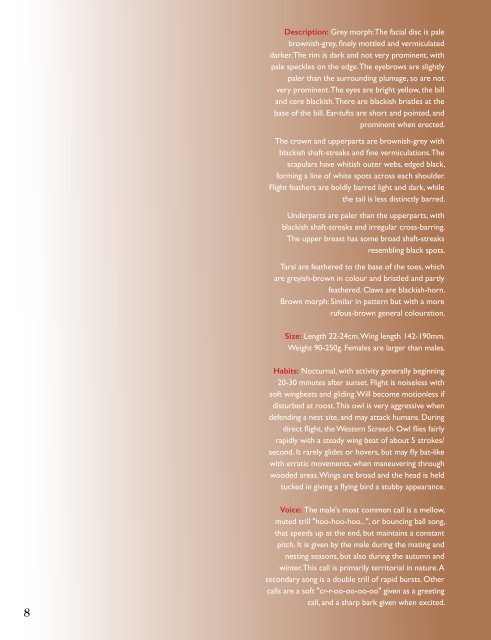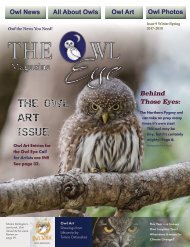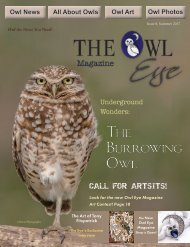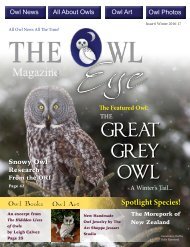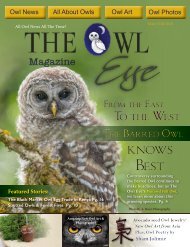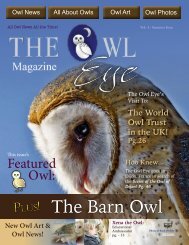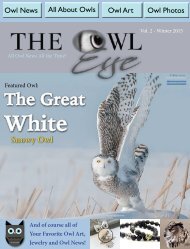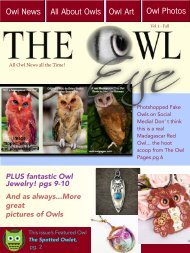Owl Eye Issue 7_int
The Spring Issue of The Owl Eye Magazine features the Western and Eastern Screech owls! Plus, the Eye's stories about the International Festival of Owls in Minnesota, a day in the life of a museum ornithologist and Birds curator, plus great images from photographers around the world.
The Spring Issue of The Owl Eye Magazine features the Western and Eastern Screech owls! Plus, the Eye's stories about the International Festival of Owls in Minnesota, a day in the life of a museum ornithologist and Birds curator, plus great images from photographers around the world.
You also want an ePaper? Increase the reach of your titles
YUMPU automatically turns print PDFs into web optimized ePapers that Google loves.
Description: Grey morph: The facial disc is pale<br />
brownish-grey, finely mottled and vermiculated<br />
darker. The rim is dark and not very prominent, with<br />
pale speckles on the edge. The eyebrows are slightly<br />
paler than the surrounding plumage, so are not<br />
very prominent. The eyes are bright yellow, the bill<br />
and cere blackish. There are blackish bristles at the<br />
base of the bill. Ear-tufts are short and po<strong>int</strong>ed, and<br />
prominent when erected.<br />
Photo By A.Bucci Photography<br />
The crown and upperparts are brownish-grey with<br />
blackish shaft-streaks and fine vermiculations. The<br />
scapulars have whitish outer webs, edged black,<br />
forming a line of white spots across each shoulder.<br />
Flight feathers are boldly barred light and dark, while<br />
the tail is less distinctly barred.<br />
Underparts are paler than the upperparts, with<br />
blackish shaft-streaks and irregular cross-barring.<br />
The upper breast has some broad shaft-streaks<br />
resembling black spots.<br />
Tarsi are feathered to the base of the toes, which<br />
are greyish-brown in colour and bristled and partly<br />
feathered. Claws are blackish-horn.<br />
Brown morph: Similar in pattern but with a more<br />
rufous-brown general colouration.<br />
Size: Length 22-24cm. Wing length 142-190mm.<br />
Weight 90-250g. Females are larger than males.<br />
Habits: Nocturnal, with activity generally beginning<br />
20-30 minutes after sunset. Flight is noiseless with<br />
soft wingbeats and gliding. Will become motionless if<br />
disturbed at roost. This owl is very aggressive when<br />
defending a nest site, and may attack humans. During<br />
direct flight, the Western Screech <strong>Owl</strong> flies fairly<br />
rapidly with a steady wing beat of about 5 strokes/<br />
second. It rarely glides or hovers, but may fly bat-like<br />
with erratic movements, when maneuvering through<br />
wooded areas. Wings are broad and the head is held<br />
tucked in giving a flying bird a stubby appearance.<br />
Voice: The male's most common call is a mellow,<br />
muted trill "hoo-hoo-hoo...", or bouncing ball song,<br />
that speeds up at the end, but ma<strong>int</strong>ains a constant<br />
pitch. It is given by the male during the mating and<br />
nesting seasons, but also during the autumn and<br />
w<strong>int</strong>er. This call is primarily territorial in nature. A<br />
secondary song is a double trill of rapid bursts. Other<br />
calls are a soft "cr-r-oo-oo-oo-oo" given as a greeting<br />
call, and a sharp bark given when excited.<br />
8 9


